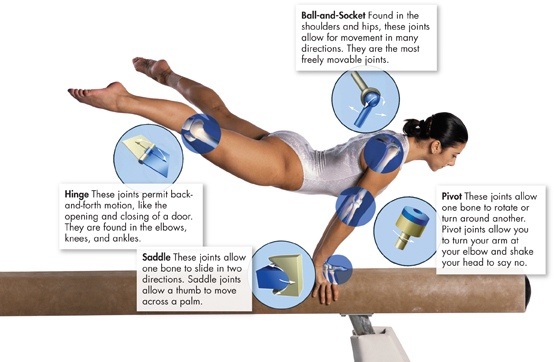Joints
 What is the role of joints?
What is the role of joints?
A place where one or more bones meet another bone is called a joint.  Joints contain connective tissues that hold bones together. Joints permit bones to move without damaging each other.
Joints contain connective tissues that hold bones together. Joints permit bones to move without damaging each other.
Types of Joints Some joints, such as those of the shoulders, allow extensive movement. Others, like the joints of the fully developed skull, allow no movement at all. Depending on its type of movement, a joint is classified as immovable, slightly movable, or freely movable.
▸ Immovable Joints Immovable joints, often called fixed joints, allow no movement. The bones at an immovable joint are interlocked and grow together until they are fused. The places where the bones in the skull meet are examples of immovable joints.
▸ Slightly Movable Joints Slightly movable joints permit a small amount of movement. Unlike the bones of immovable joints, the bones of slightly movable joints are separated from each other. The joints between the two bones of the lower leg and the joints between vertebrae are examples of slightly movable joints.
▸ Freely Movable Joints Freely movable joints permit movement in two or more directions. Freely movable joints are grouped according to the shapes of the surfaces of the adjacent bones. Several types of freely movable joints are shown in Figure 32–3.
BUILD Vocabulary
ACADEMIC WORDS The adjective adjacent means “lying near” or “next to.” Joints can form only at adjacent bones.

FIGURE 32–3 Freely Movable Joints Freely movable joints make actions possible. Many freely movable joints are involved in the movements this gymnast needs for her routine.
ddTable of Contents
- Formulas and Equations
- Applying Formulas and Equations
- Mean, Median, and Mode
- Estimation
- Using Measurements in Calculations
- Effects of Measurement Errors
- Accuracy
- Precision
- Comparing Accuracy and Precision
- Significant Figures
- Calculating With Significant Figures
- Scientific Notation
- Calculating With Scientific Notation
- Dimensional Analysis
- Applying Dimensional Analysis




